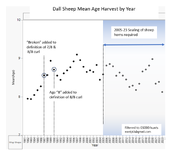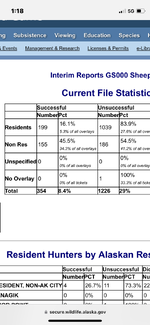Some of you here probably remember that sheep town hall we had in Wasilla in 2015 when prop 207 was coming before the board. The room was packed! And every single one of the longtime sheep hunters spoke about the hundreds of sheep they would see every year where they hunted, and how it was so greatly diminished now. Lew Bradley's book(s) are a good overview. And if we could go back to pre market-hunting days for that delicious sheep meat, the story would be the same, except it was many hundreds of sheep.
Sheep have been slowly and steadily declining for a long time. And once they get so low it's really hard to rebound with successive weather events. Some things are gonna have to change. Obviously, sheep conservation should be the #1 priority. Re any hunting related effects, I do think taking a look at moving to a strict FC/broomed or no FC/broomed and doing away with the age requirement may help with sub-legal harvest, the counting of annuli going on when there are fewer legal rams. There doesn't seem to be any real efficacy in sheep-specific predation control plans if we can't deal with the eagles. Supplemental feeding where there are winter nutrition issues isn't really on the table.
More draw-only hunts and closures are likely, on both state and fed side. Who gets what part of the shrinking pie is what we're down to.


